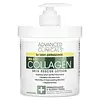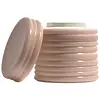What's inside
What's inside
 Key Ingredients
Key Ingredients

 Benefits
Benefits

 Concerns
Concerns

 Ingredients Side-by-side
Ingredients Side-by-side

Water
Skin ConditioningParaffinum Liquidum
EmollientCetearyl Alcohol
EmollientGlyceryl Stearate Se
EmulsifyingIsopropyl Myristate
EmollientGlycerin
HumectantButylene Glycol
HumectantCeteareth-20
CleansingCaprylic/Capric Triglyceride
MaskingHydrolyzed Collagen
EmollientAloe Barbadensis Leaf Juice
Skin ConditioningCamellia Sinensis Leaf Extract
AntimicrobialAnthemis Nobilis Flower Extract
MaskingAcrylates/C10-30 Alkyl Acrylate Crosspolymer
Emulsion StabilisingTetrasodium Glutamate Diacetate
Maltodextrin
AbsorbentPhenoxyethanol
PreservativeIodopropynyl Butylcarbamate
PreservativeCaprylyl Glycol
EmollientSodium Hydroxide
BufferingSodium Carbonate
BufferingSodium Chloride
MaskingWater, Paraffinum Liquidum, Cetearyl Alcohol, Glyceryl Stearate Se, Isopropyl Myristate, Glycerin, Butylene Glycol, Ceteareth-20, Caprylic/Capric Triglyceride, Hydrolyzed Collagen, Aloe Barbadensis Leaf Juice, Camellia Sinensis Leaf Extract, Anthemis Nobilis Flower Extract, Acrylates/C10-30 Alkyl Acrylate Crosspolymer, Tetrasodium Glutamate Diacetate, Maltodextrin, Phenoxyethanol, Iodopropynyl Butylcarbamate, Caprylyl Glycol, Sodium Hydroxide, Sodium Carbonate, Sodium Chloride
Water
Skin ConditioningRicinus Communis Seed Oil
MaskingGlycerin
HumectantCetearyl Alcohol
EmollientGlyceryl Stearate
EmollientSimmondsia Chinensis Seed Oil
EmollientSodium Lactate
BufferingHydrogenated Castor Oil
EmollientPEG-40 Stearate
EmulsifyingColloidal Oatmeal
AbsorbentSodium Hyaluronate
HumectantRetinol
Skin ConditioningLeuconostoc/Radish Root Ferment Filtrate
AntimicrobialPanthenol
Skin ConditioningGlycine Soja Oil
EmollientHippophae Rhamnoides Fruit Oil
Skin ProtectingLactic Acid
BufferingAllantoin
Skin ConditioningSodium Phytate
Malt Extract
Skin ProtectingTocopheryl Acetate
AntioxidantXylose
HumectantFructan
Skin ConditioningSorbitan Isostearate
EmulsifyingHydroxyethyl Acrylate/Sodium Acryloyldimethyl Taurate Copolymer
Emulsion StabilisingPolyglutamic Acid
Skin ConditioningEthylhexylglycerin
Skin ConditioningSodium Hyaluronate Crosspolymer
HumectantParfum
MaskingButylene Glycol
HumectantPolyacrylate Crosspolymer-6
Emulsion StabilisingT-Butyl Alcohol
Perfuming1,2-Hexanediol
Skin ConditioningPhenoxyethanol
PreservativeBenzyl Salicylate
PerfumingLinalool
PerfumingWater, Ricinus Communis Seed Oil, Glycerin, Cetearyl Alcohol, Glyceryl Stearate, Simmondsia Chinensis Seed Oil, Sodium Lactate, Hydrogenated Castor Oil, PEG-40 Stearate, Colloidal Oatmeal, Sodium Hyaluronate, Retinol, Leuconostoc/Radish Root Ferment Filtrate, Panthenol, Glycine Soja Oil, Hippophae Rhamnoides Fruit Oil, Lactic Acid, Allantoin, Sodium Phytate, Malt Extract, Tocopheryl Acetate, Xylose, Fructan, Sorbitan Isostearate, Hydroxyethyl Acrylate/Sodium Acryloyldimethyl Taurate Copolymer, Polyglutamic Acid, Ethylhexylglycerin, Sodium Hyaluronate Crosspolymer, Parfum, Butylene Glycol, Polyacrylate Crosspolymer-6, T-Butyl Alcohol, 1,2-Hexanediol, Phenoxyethanol, Benzyl Salicylate, Linalool
 Reviews
Reviews

Ingredients Explained
These ingredients are found in both products.
Ingredients higher up in an ingredient list are typically present in a larger amount.
Butylene Glycol (or BG) is used within cosmetic products for a few different reasons:
Overall, Butylene Glycol is a safe and well-rounded ingredient that works well with other ingredients.
Though this ingredient works well with most skin types, some people with sensitive skin may experience a reaction such as allergic rashes, closed comedones, or itchiness.
Learn more about Butylene GlycolCetearyl alcohol is a mixture of two fatty alcohols: cetyl alcohol and stearyl alcohol. It is mainly used as an emulsifier. Emulsifiers help prevent the separation of oils and products. Due to its composition, it can also be used to thicken a product or help create foam.
Cetearyl alcohol is an emollient. Emollients help soothe and hydrate the skin by trapping moisture.
Studies show Cetearyl alcohol is non-toxic and non-irritating. The FDA allows products labeled "alcohol-free" to have fatty alcohols.
This ingredient is usually derived from plant oils such as palm, vegetable, or coconut oils. There is debate on whether this ingredient will cause acne.
Due to the fatty acid base, this ingredient may not be Malassezia folliculitis safe.
Learn more about Cetearyl AlcoholGlycerin is already naturally found in your skin. It helps moisturize and protect your skin.
A study from 2016 found glycerin to be more effective as a humectant than AHAs and hyaluronic acid.
As a humectant, it helps the skin stay hydrated by pulling moisture to your skin. The low molecular weight of glycerin allows it to pull moisture into the deeper layers of your skin.
Hydrated skin improves your skin barrier; Your skin barrier helps protect against irritants and bacteria.
Glycerin has also been found to have antimicrobial and antiviral properties. Due to these properties, glycerin is often used in wound and burn treatments.
In cosmetics, glycerin is usually derived from plants such as soybean or palm. However, it can also be sourced from animals, such as tallow or animal fat.
This ingredient is organic, colorless, odorless, and non-toxic.
Glycerin is the name for this ingredient in American English. British English uses Glycerol/Glycerine.
Learn more about GlycerinPhenoxyethanol is a preservative that has germicide, antimicrobial, and aromatic properties. Studies show that phenoxyethanol can prevent microbial growth. By itself, it has a scent that is similar to that of a rose.
It's often used in formulations along with Caprylyl Glycol to preserve the shelf life of products.
Water. It's the most common cosmetic ingredient of all. You'll usually see it at the top of ingredient lists, meaning that it makes up the largest part of the product.
So why is it so popular? Water most often acts as a solvent - this means that it helps dissolve other ingredients into the formulation.
You'll also recognize water as that liquid we all need to stay alive. If you see this, drink a glass of water. Stay hydrated!
Learn more about Water